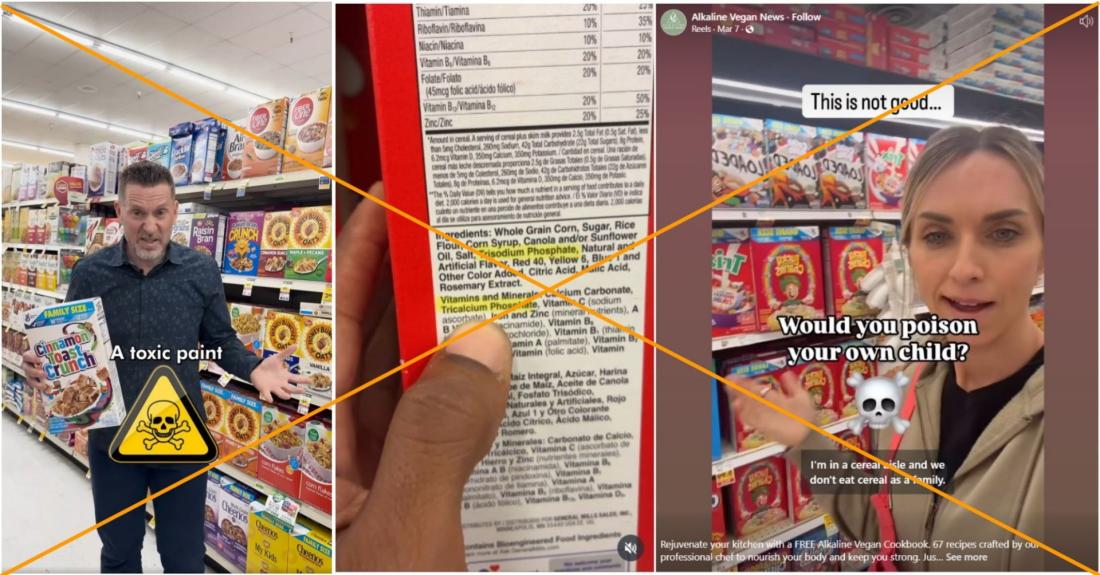
Health influencers mislead on cereal ingredient
- Published on August 27, 2025 at 22:50
- 4 min read
- By Marisha GOLDHAMER, AFP USA
"Let's talk about Trisodium Phosphate. It sounds like a harmless food name. But it's not just a 'food ingredient,'" an August 19, 2025 Instagram post claims. "It's a powerful chemical used in: Industrial cleaning products."
In the attached video, a woman examines the ingredients of a cereal box taken off a supermarket shelf and then conducts an internet search that shows TSP for sale as a heavy-duty cleaning product.
Another video asks: "Are you eating toxic paint cleaner for breakfast?"
That clip starts in the cereal aisle of a supermarket and concludes at the home improvement store Home Depot, highlighting a label on a container of TSP that cautions against swallowing or inhaling the chemical cleaner.
"If you see TSP on any food label, especially your kid's cereal, put it back on the shelf," says the man in the video, who goes by NonToxicDad on TikTok.

Similar claims have circulated across platforms for years, but cereal ingredients were thrust into the spotlight in July when the US Department of Health and Human Services announced a pledge from the Consumer Brands Association to remove synthetic food dyes from its products (archived here and here).
"Dyes...What about removing trisodium phosphate and the other chemical ingredients?" an August 16 Facebook post asks.
AFP has previously reported on wellness influencers, particularly those affiliated with the Make America Healthy Again movement, who amplified specious claims about the ingredients of shelf-stable foods sold in the United States.
Medical associations are concerned about the quantity of ultra-processed foods in the American diet, but experts told AFP the alarm over trisodium phosphate in breakfast cereal is misleading (archived here).
"I certainly find it misinforming and focusing very narrowly on what the ingredient is," Laura Bellows, an associate professor of nutritional sciences at Cornell University, told AFP on August 22 (archived here).
The videos omit context "as to how chemicals that can happen naturally are used for a variety of things," she said.
Bellows, whose research focuses on early childhood eating habits, said she would prefer people get phosphates from whole foods, such as dairy, beans or legumes, but that TSP added to items is "not as harmful as these videos are making it out to be."
Food grade
The US Food and Drug Administration (FDA) and the European Food Safety Association have approved TSP for use in food products ranging from deli meats to packaged cakes (archived here and here).
General Mills, the maker of the cereals targeted in the popular videos, explains its use of the food additive on its website: "We use small amounts of trisodium phosphate in some of our cereals to help improve the texture, making every bite crunchy and delicious" (archived here).
The videos online are correct that TSP is also used in cleaning products, and that the industrial formulation is considered dangerous if ingested or inhaled (archived here).
But there is a food-grade version of the chemical the FDA considers "generally recognized as safe" (archived here).
European regulators have also found no concerns with respect to TSP causing cancer or genetic damage (archived here).
Quantity also matters.
"In any food formulation, you rarely find very high concentration," Francisco Diez-Gonzalez, director of the Center for Food Safety at the University of Georgia, told AFP (archived here).
He said the videos prey on a lack of understanding of basic chemistry.
"What they do is they exploit the fact that it is the same useful compound that is used in other purposes, completely different to food consumption," he said August 21.
He pointed to sodium bicarbonate, or baking soda, as another example of a product that can be used for cleaning but is also regularly consumed in pastries.
Diez-Gonzalez also said removing phosphate salts from products would have widespread consequences for the food supply because its preservative function is essential to shelf life and taste.
"It's not as simple as with the artificial dye. That is probably only a change in color," he said.
"If we withdraw many of those ingredients, the food's not going to be palatable relatively quickly."
Maximum levels
Diez-Gonzalez said consumers should nonetheless understand the total quantity of phosphate salts they are consuming to be able to make informed decisions.
Inorganic phosphorus, such as TSP, is absorbed by the human body at a much higher percentage than the organic phosphorus found in animal and plant foods including seeds, nuts and legumes (archived here and here).
He sent AFP a paper, published in the American Journal of Clinical Nutrition, that examined both the organic and inorganic phosphate additives in products sold by the top 25 manufacturers in the United States (archived here).
It called on the FDA "to make labeling of the total phosphorus content on nutrition facts labels mandatory," a recommendation he supports.
He said this would be particularly helpful to patients with kidney disease or on dialysis, as they are advised to restrict items with phosphorus-containing food additives (archived here).
European regulators have also recommended the introduction of maximum permitted levels of phosphates used as additives (archived here).
Still, Cornell's Bellows said: "It would be very difficult for the average American to reach the upper limit eating a relatively healthy diet."
More of AFP's reporting on health misinformation is available here.
Copyright © AFP 2017-2025. Any commercial use of this content requires a subscription. Click here to find out more.
Is there content that you would like AFP to fact-check? Get in touch.
Contact us
